Family : Orchidaceae

Text © Prof. Pietro Pavone

English translation by Mario Beltramini
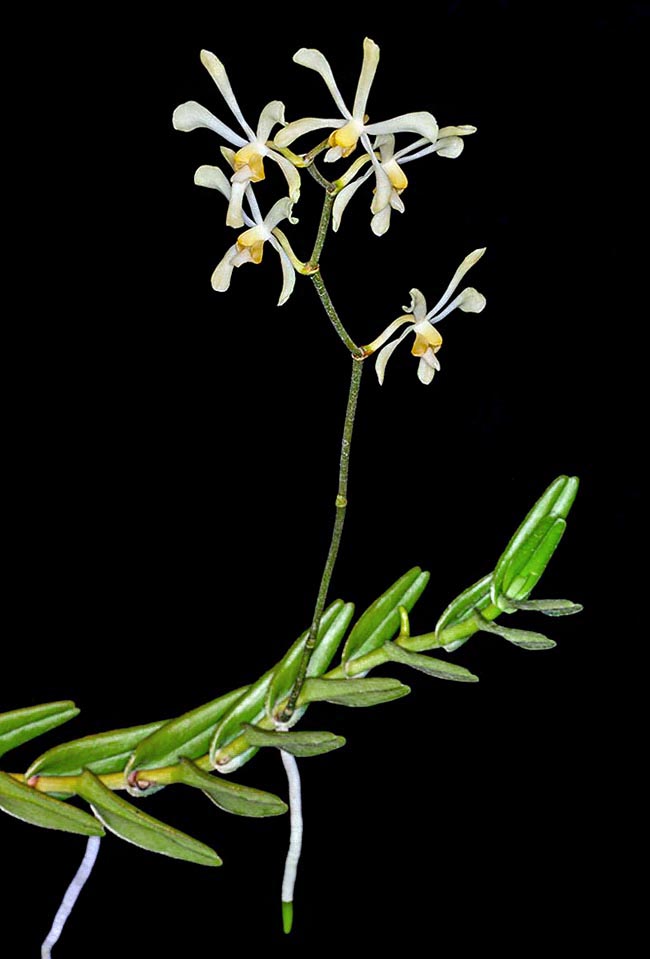
Endangered in wild, Arachnis hookeriana is an epiphyte or a lithophyte, of peninsular Malaysia, Vietnam and Borneo © Giuseppe Mazza
Arachnis hookeriana (Rchb.f.) Rchb.f. (1886) is a species of the subtribe Aeridinae, tribe Vandeae, subfamily Epidendroideae and family Orchidaceae.
It is found in the thicket or on the rocky outcrops of peninsular Malaysia, from the sea level up to 500 m of altitude.
It is present also in Vietnam, in Borneo, and, yore, in the islands off Singapore.
The name of the genus Arachnis comes from the Greek ἀράχνη (aráchne), spider, because the flower recalls the appearance of a spider or of a scorpion.
The specific epithet is honoured to Sir Joseph Dalton Hooker (1817-1911) who was one of the greatest botanists and explorers of Victorian Britain.
Close friend of Charles Darwin, he was the second director of Kew Royal Botanical Gardens from 1865 to 1885, succeeding his father, William Jackson Hooker (1785-1865).
He discovered several species of Himalayan rhododendrons and in various publications he described Asian orchids (“Flora of Tasmania” (1860); “Flora of British India” (1875); “A Century of Indian Orchids” (1895).
This species, commonly called “Hooker’s Arachnis”, is in danger of extinction in the wild and therefore is protected against trade and as such inserted into the Appendix II of Washington Convention (CITES, Convention on International Trade in Endangered Species of wild fauna and flora) which has the purpose of protecting the animal and vegetal species at risk of extinction, hindering their trade and, in particular, their export and possession.
Arachnis hookeriana is an epiphyte, lithophyte at times, fast growing, monopodial, without pseudobulbs, with very elongated stem carrying up to 9 cm long and 2 cm broad leaves, close each other, sheathing at the base of the stem, rigid and with bolobate apex.
The inflorescence is lateral and erect, about 60 cm long, with 6-8 (10-15) flowers.
The flowers, 6,5. x 5,5 cm large, are fleshy, fragrant, of pale yellow colour getting more intense at the extremities of the tepals.
The lateral tepals are curved downwards and alongwith the outer median tepal confer the flower the look of a spider or of a scorpion.
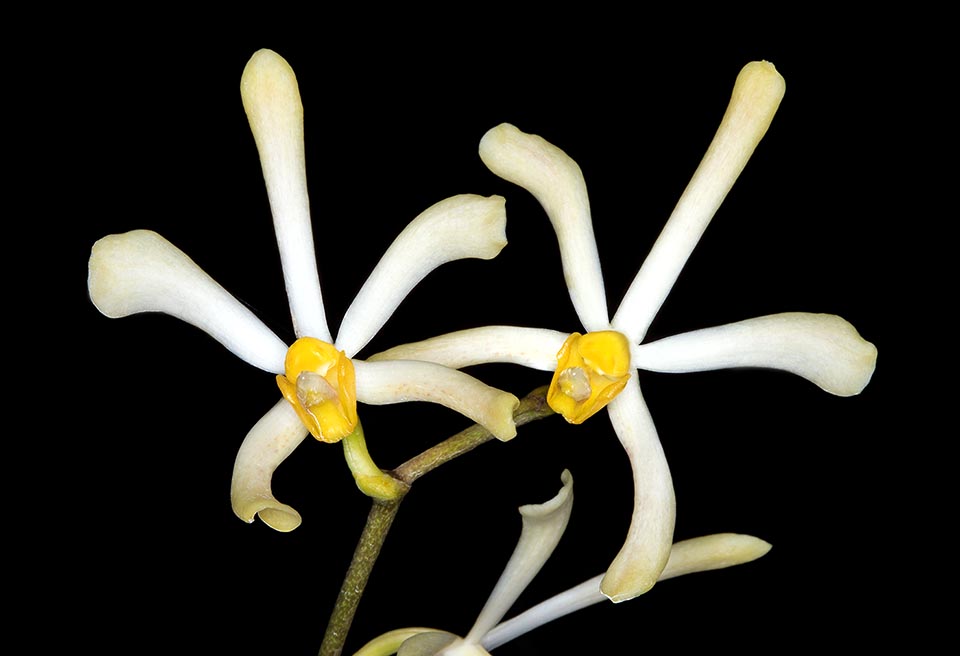
Without pseudobulbs, has a very long stem and an about 60 cm erect inflorescence with fleshy fragrant flowers that exceed the 6 cm © Giuseppe Mazza
The lip is short, trilobate. The filaments of the stamens are partially merged to the style forming a short and robust column (gynostemium, gymnostemium) with a glutinous gland (viscidium) broadly ovate in order to better adhere to the body of the pollinating insects.
The pollinia are 4 and look like unequal, waxy masses. The fruits are capsules freeing numerous pulverulent seeds, having no endosperm.
In the south-western zone of the Malayan peninsula (Malacca) and in Vietnam, in the semi deciduous and deciduous plain forests, at altitudes from the sea level up to 700 meters, has been found the natural hybrid Arachnis × maingayi (Hook. f.) Schltr. (1911) that originates from Arachnis flos-aeris (L.) Rchb. f. and Arachnis hookeriana.
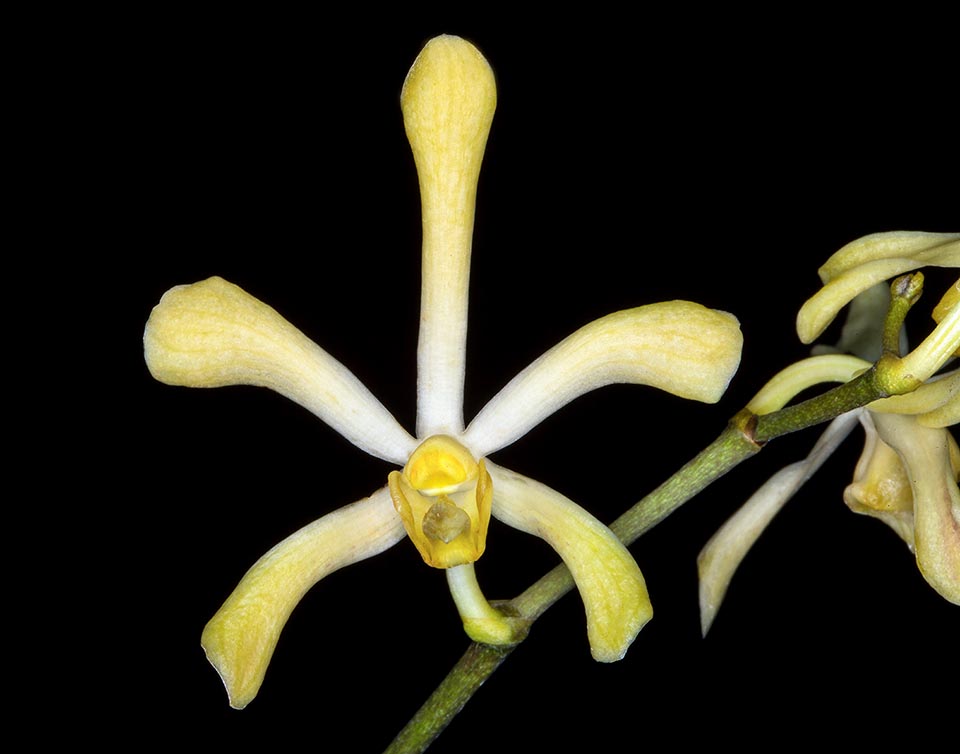
The variety Arachnis hookeriana var. luteola has yellow shades, more intense at the apex of the tepals, whilst the lip is pale yellow © Giuseppe Mazza
It is a big epiphyte, with long stem, alternate, rigid leaves and up to 50 cm long inflorescences with big flowers (up to 5 cm), of pale yellow colour with red-brown bars at the extremities. It blooms in summer.
Three varieties are known, the most common is Arachnis hookeriana var. alba with the tepals stained purple in their central part and purple lip with darker stripes. Arachnis hookeriana var. luteola with yellow tepals, more yellow towards the apex, whilst the lip is pale yellow.
This variety has been chosen by the hybridizers as it forms hybrids with sparkling colours and with richer inflorescences suitable to be utilized as cut flowers.
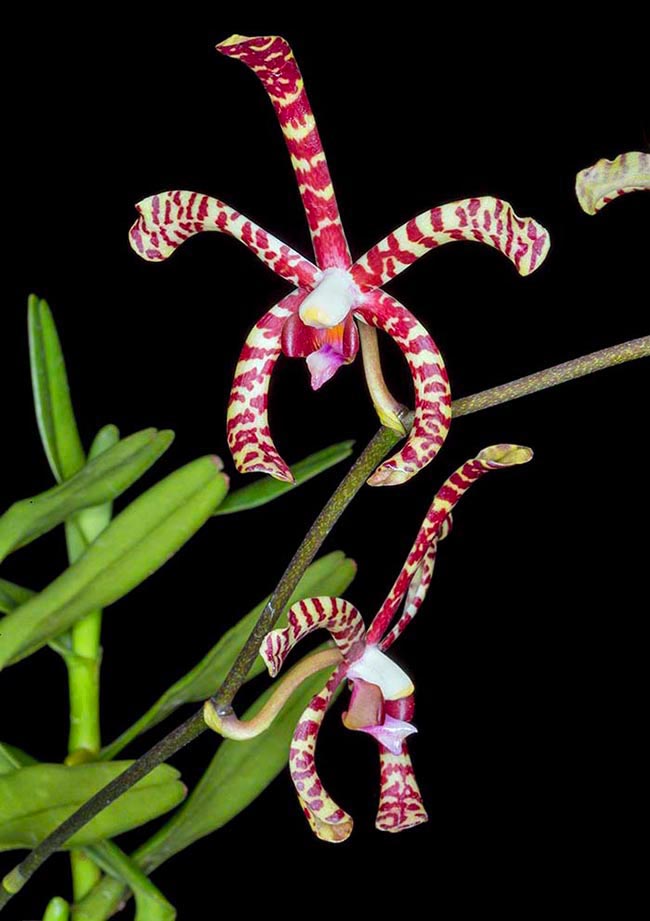
Arachnis x maingayi is a natural hybrid with Arachnis flos-aeris. The flower looks just like a spider or a scorpion © Giuseppe Mazza
Arachnis hookeriana var. viridipes has green stem, white tepals and lips with purple stripes.
Arachnis hookeriana is a rustic species and of frequent blooming and due to its economical validity has been utilized as a pârent for the development of artificial hybrids for getting cut flowers and pot plants.
As a matter of fact, from this species they have obtained hundreds of registered hybrids.
For instance, cut flowers of a particular commercial importance can be obtained from digenetic hybrids Aranda and (Arachnis × Vanda) trigenetic Mokara (Arachnis × Vanda × Ascocentrum).
An interesting hybrid Aeridachnis Bogor ‘Apple Blossoms’ has been obtained through crossing between Arachnis hookeriana × Aerides odorata. Its flowers, which give off a delicate and sweet fragrance, are apple-green when in bud and white with pink shades on the lip when open.
The cut inflorescences are suitable as table flowers because of their particular scent that renders pleasant the environment.
A very popular hybrid for its dark yellow flowers with pale brown streaks is Arachnis Maggie Oei obtained in 1950 by John Laycock (1887-1960) by crossing between Arachnis hookeriana × Arachnis flos-aeris.
To this hybrid was given the name of Aranda ‘Deborah’ to honour the eldest daughter of Prof. Richard Eric Holttum (1895-1949) who was the director of Singapore botanical gardens from 1925 to 1949.
From the crossing between Arachnis hookeriana × Vanda ‘Golden Moon’, was obtained another hybrid whose name is honoured to the prime minister founder of Singapore who passed away in 2015.
This plant produces inflorescences with 10 flowers and each flower has a diametre of 9,5 to 10,5 cm. The tepals are of yellow-bright gold, greenish colour. The lip is waxy and is light brown.
The plants of Arachnis hookeriana are normally cultivated in suspended baskets and in full sunlight, with warm temperatures and a good circulation of air. If the roots get out from the baskets, they must be irrigated frequently.
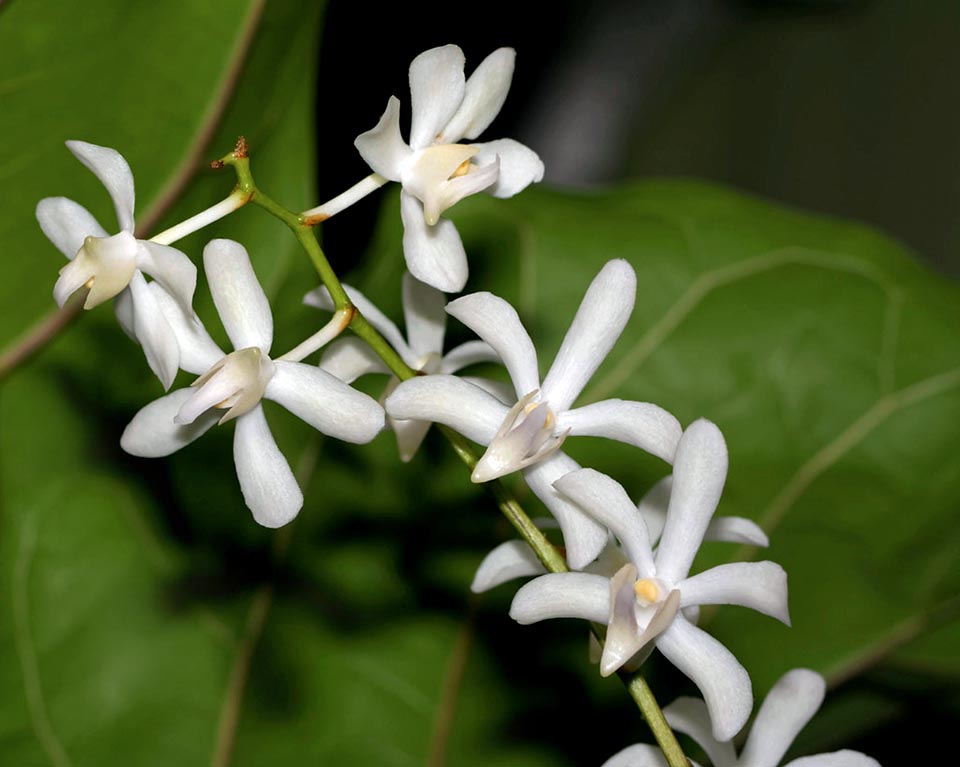
The hybrids born also from other genera are numerous. For example here Aeridachnis Bogor ‘Apple Blossom Alba’ got by crossing with Aerides odorata © Dan Ripplinger
The container, preferably big, must have supports that can easily drain the water like tree fern fibres, bark of fir and charcoal, or sphagnum moss. Moreover, this loam must be maintained with high and uniform humidity.
It is recommended to fertilize, every two weeks, with a balanced fertilizer based on Nitrogen, Phosphorus, Potassium (20-20-20) with microelements: Manganese, Boron, Copper, Molybdenum, Zinc and Iron.
Synonyms: Arachnanthe alba Ridl. (1893); Arachnis alba (Ridl.) Schltr. (1911); Arachnis canniformis (Guillaumin) Tang & F.T.Wang (1951); Renanthera alba (Ridl.) Ridl. (1896) ; Renanthera hookeriana Rchb.f. (1862); Stauropsis canniformis Guillaumin (1930).
